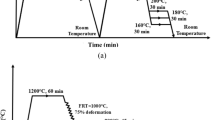Abstract
This paper states that due to special thermocyclic treatment (TCT) performed in the range of relatively low annealing temperatures it is possible to modify morphology, composition and size distribution of carbides constituting ledeburitic eutectics. As a result it becomes possible to substantially increase a level of process hot plasticity of high-speed steel due to obtaining optimal size distribution of eutectic carbides. It has been revealed that globular microstructure having lots of evenly distributed carbides of round shape in the ferritic matrix seems to be favorable from the point of view of hot plasticity. It is expedient to have a large quantity of small secondary carbides along with large quantity of eutectic carbides of medium size (1÷3 mkm), and the least possible quantity of large carbides (>5 mkm) in the microstructure. TCT mode has been developed, during which structure condition with favorable carbide phase morphology is being formed in high-speed steel. Due to this metal bars’ hot plasticity essentially increases. The particularity of this method consists in combination of heat treatment accompanied with soaking at maximum and minimum temperatures at which multitude of centers of secondary carbide phase condensation starts shaping due to constant temperature gradient, with heat treatment in the range of pearlite decomposition for growth and coagulation of carbide phase. TCT of high-speed steel ensures ×1.5–2 decrease in average size and ×1.5–2 increase in density of eutectic carbides distribution, thanks to which metal bars process hot plasticity increases substantially (by 25–30%), carbide heterogeneity becomes 1–1.5 number less. Compared to conventional annealing TCT method ensures depletion of solid solution with Molybdenum by 48%, Tungsten by 44.5%, and Vanadium by 24.8%, and increase in Chromium alloyability by 10%. This is related to formation of carbides of Tungsten, Molybdenum type M6C and Vanadium type MC, and dissolution of Chromium-based carbides M23C6 and M7C3.
Similar content being viewed by others
References
I.N. Golikov, S.B. Maslenkov, in Metallurgy (Moscow, 1977) p. 203–216
S.A. Zinchenko, M.I. Makhnev, P.A. Shamshurin, Steel 7, 108 (2010)
S.A. Zinchenko, M.I. Makhnev, P.A. Shamshurin, Method of high-speed steel annealing, patent for invention no. 2336337 RU 2 336 337 С1 C21D 9/22, C21D 1/26, Publ. bull, no. 29, 2008
S.A. Zinchenko, L.V. Tarasenko, I.A. Panteleyev, in Thermocyclic annealing of high-speed steel semi-products, Blank productions in machine building (2011), No.2, pp. 36–41
Author information
Authors and Affiliations
Corresponding author
Rights and permissions
About this article
Cite this article
Zinchenko, S.A. Thermocyclic treatment (TCT) – as a method to decrease carbide segregation of hypereutectoid steels. Eur. Phys. J. Spec. Top. 229, 459–465 (2020). https://doi.org/10.1140/epjst/e2019-900107-0
Received:
Published:
Issue Date:
DOI: https://doi.org/10.1140/epjst/e2019-900107-0




